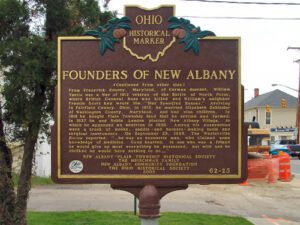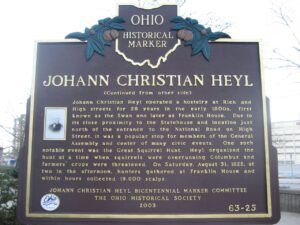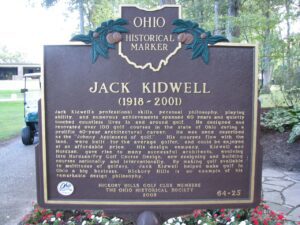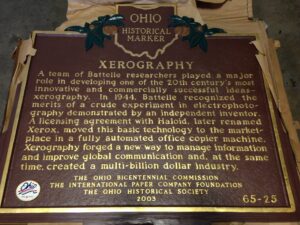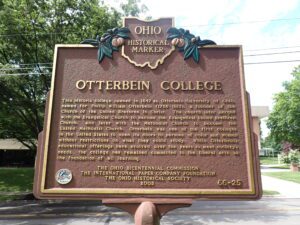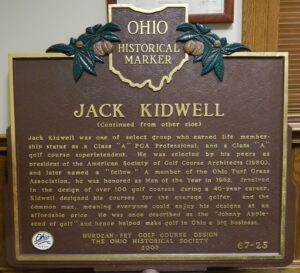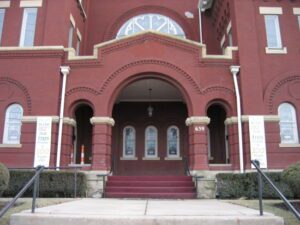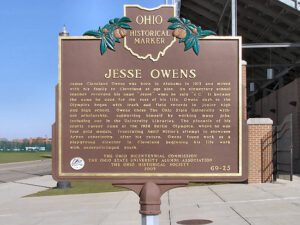, OH
A tavern and inn, for which Noble Landon (1783-1866) obtained a liquor license in 1835, formerly occupied the southeast corner of High and Main streets. In 1837 Landon and William Yantis laid out the town of New Albany in 50-by-100-foot lots, with Landon’s lots lying on the east side and Yantis’ on the west side of High Street. Landon was born in Litchfield, Connecticut, lived as a young man in St. Albans, Vermont, and migrated to Licking County, Ohio, in 1810. He was the first clerk and first Justice of the Peace in St. Albans Township and first postmaster in Johnstown and later in New Albany. In addition to contributions as a builder-developer, Landon gave to the village lore the story of a remarkable conversion. Long known as a heavy drinker, he suddenly ordered kegs of whiskey he owned to be carried into the street and broken. He then attended church regularly. (continued on other side)
, OH
Johann Christian Heyl (1788-1877), the first German and first Lutheran to settle in Columbus, was one of the original 15 settlers of the city. A baker by trade, Heyl came to bake for the soldiers quartered in Franklinton during the War of 1812. He founded the city’s first Lutheran Church and helped financially underwrite the German Theological Seminary, which later became Capital University. An early civic leader, Heyl served on City Council for 14 years, was County Treasurer for 8 years, an associate judge in the Court of Common Pleas for 14 years, was appointed to the first public school board, and was the first Chief of the Fire Department. His Sunbury Road home was a stop on the Underground Railroad. (continued on other side)
, OH
Self-educated golfer Jack Kidwell grew up in central Ohio. From 1937 until 1971, he owned and operated the Beacon Light Golf Course, where he started as a caddie. In 1943, he married Geraldine “Jerry” Kidwell, his wife of 57 years, and had four daughters, Sally, Shirley, Kathy, and Jody. Kidwell became a Class “A” golf course superintendent and earned life membership status as a Class “A”PGA professional. His peers selected Kidwell as president of the American Society of Golf Course Architects in 1980. A member of the Ohio Turf Grass Association, he was honored as Man of the Year in 1982. His accomplishments gained him induction into the Southern Ohio PGA Hall of Fame in 1977 and the Ohio Golf Association Hall of Fame in 1997.
, OH
A team of Battelle researchers played a major role in developing one of the 20th century’s most innovative and commercially successful ideas–xerography. In 1944, Battelle recognized the merits of a crude experiment in electrophotography demonstrated by an independent inventor. A licensing agreement with Haloid, later renamed Xerox, moved this basic technology to the marketplace in a fully automated office copier machine. Xerography forged a new way to manage information and improve global communication and, at the same time created a multi-billion dollar industry.
, OH
This historic college opened in 1847 as Otterbein University of Ohio, named for Philip William Otterbein (1726-1813), a founder of the Church of the United Brethren in Christ. The church later merged with the Evangelical Church to become the Evangelical United Brethren Church, and later with the Methodist Church to become the United Methodist Church. Otterbein was one of the first colleges in the United States to open its doors to persons of color and women without restrictions on what they could study. While Otterbein’s educational offerings have evolved over the years to meet society’s needs, the college has remained committed to the liberal arts as the foundation of all learning.
, OH
Born on September 21, 1918, golf course architect Jack Kidwell attended Columbus Central High School where he became the Ohio School State Golf Champion in 1937. Kidwell was the owner and operator of Beacon Light Golf Course from 1937-1971. He was inducted into both the Southern Ohio PGA Hall of Fame and the Ohio Golf Association Hall of Fame in 1997. He was the founding father of Hurdzan/Fry Golf Course Design and the inspirational leader to this day. Kidwell was a true giant of the golf industry and has been named the person having the most influence on golf in the state of Ohio over the past 200 years. He was married to his wife Geraldine “Jerry” Kidwell for 57 years and they had four daughters, Sally, Shirley, Kathy, and Jody. Jack Kidwell died on April 29, 2001.
, OH
Organized in 1823 as Bethel African Methodist Episcopal Church, St. Paul A.M.E. Church is the oldest congregation of African descent in Columbus. The church, founded by Moses Freeman and 13 other members from the Town Street Church, was originally located on the east side of Lazelle Street. Several buildings were erected to meet the needs of the growing congregation. The present edifice, located at 639 E. Long Street, was completed in 1906. St. Paul has several outreach ministries, including The Prison Ministry, Alzheimer Ministry, Karen’s House, Community Development Corporation, Health Concerns Committee, St. Paul Tutorial and Enrichment Program (STEP), St. Paul Scholarship Program, St. Paul Drama Ministry, Jam’N Jefferson Park Festival, and Church Without Walls.
, OH
James Cleveland Owens was born in Alabama in 1913 and moved with his family to Cleveland at age nine. An elementary school teacher recorded his name “Jesse” when he said “J.C.” It became the name he used for the rest of his life. Owens’ dash to the Olympics began with track and field records in junior high and high school. Owens chose The Ohio State University without scholarship, supporting himself by working many jobs, including one in the University Libraries. The pinnacle of his sports career came at the 1936 Berlin Olympics, where he won four gold medals, frustrating Adolf Hitler’s attempt to showcase Aryan superiority. After his return, Owens found work as a playground director in Cleveland beginning his life work with underprivileged youth.


